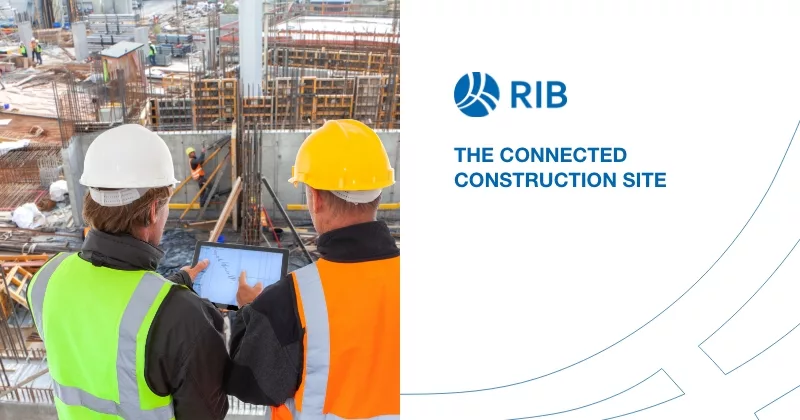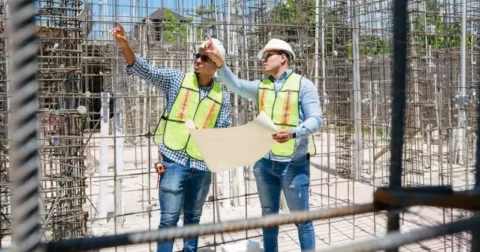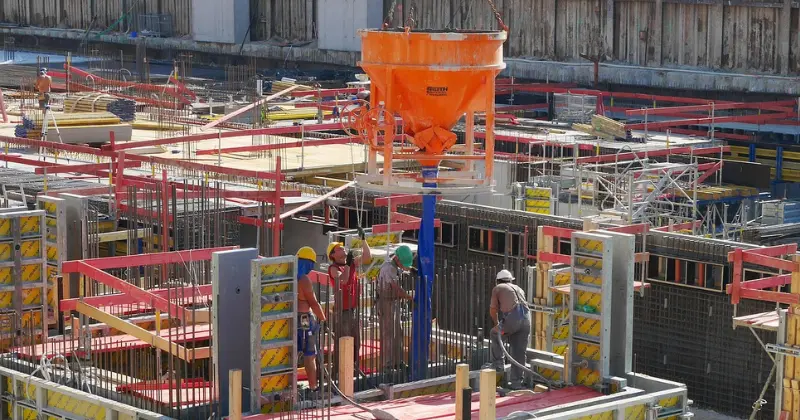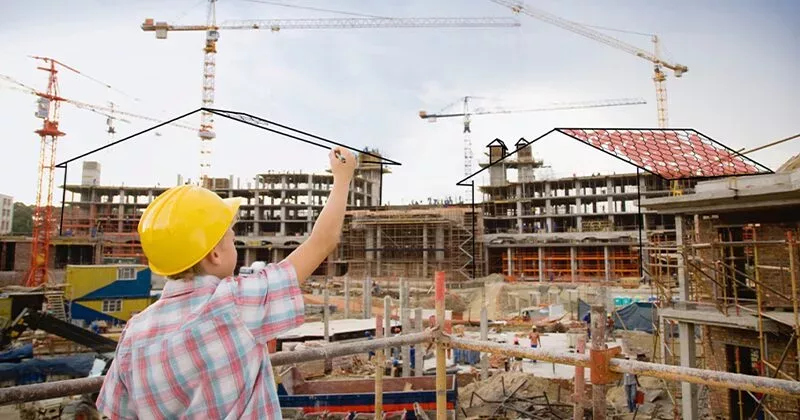10 mins read
18 Interesting Construction Facts that Make the Industry Unique

With an industry history dating back to the earliest days of humanity, there is no shortage of surprising and interesting construction facts. Incredible accomplishments and historical records are balanced by unexpected trends and findings that make construction an ongoing source of fascination for people both inside and outside the industry.
Our list of interesting construction facts also points to ongoing industry growth and a worldwide appetite for qualified construction professionals. The recent influx of innovative technology and sustainable practices should ensure these positive trends continue. With the help of advanced construction software solutions and unlimited imagination, many industry records could soon be in jeopardy.
Construction Industry Records
1. The world’s tallest building
The six tallest man-made structures in the world are now located in the Middle East or Asia, led by the 163-floor Burj Khalifa building in Dubai. Built in 2010 and standing an astonishing 828 meters high, the building is a full 150 meters taller than the second tallest structure, the Merdeka 118 building in Kuala Lumpur, completed in 2023.
In terms of sheer volume, there is still no topping the Boeing Company airplane assembly facility in the United States, with its interior volume of 13.3 million cubic meters. For comparison, the Boeing factory is large enough to comfortably house 75 standard American football fields.
2. The world’s longest bridge
The world’s longest bridge, the Danyang-Kunshan Grand Bridge in China, was also completed in 2010. The bridge spans over 164 kilometers, which is nearly the distance between the coast of South Korea and Japan. Constructed to support railway expansion, only 9 kilometers of the bridge span open waters, but it still maintains an average height of nearly 31 meters off the ground.
3. The world’s longest structure
The length of the longest bridge pales in comparison to the world’s longest structure. Completed almost 500 years ago, the Great Wall of China spans over 21,000 kilometers and is still the only human-made structure visible from space.
The Great Wall is also known for being the second-longest continuous construction project ever undertaken, with a total build time of approximately 2,000 years. Only Stonehenge in the UK is believed to have taken longer to build.
4. The world’s oldest wooden building
No wooden building can compare to the age of ancient brick and stone structures like the Great Pyramid of Giza, but the wood-framed Horyuji Pagoda in Japan has been around since the year 607 AD, or over 1,400 years. At the time of construction, the old growth Japanese Cypress trees used to complete the building had already been standing for over 2,000 years, pointing out the enduring value of reclaimed lumber for sustainable construction.
5. The Neom Project will cost USD $1.5 trillion
The Neom Project in Saudi Arabia, also known as “The Line,” graces our list of construction facts as the most expensive construction project of all time. The Line is an ambitious new city of tomorrow that will be powered exclusively by green energy and will eventually be home to up to 1.5 million people. The nickname is based on the unusual geography: The city will cover a narrow stretch of land approximately 170 kilometers long when it is completed in 2030.
Incredible Material Consumption
6. 1.5 trillion bricks produced each year
While more sustainable and cost-effective construction materials have been developed since the first bricks were made almost 5,000 years ago, this ancient staple of construction has hardly gone out of style, with 1.5 trillion bricks produced per year. Stacked end to end, these bricks could reach the moon…over 700 times!
7. Construction is still #1 in steel consumption (by far)
Annually published construction facts show that steel production has been holding steady at approximately 1.8 billion metric tons per year, and the construction industry remains the largest consumer of steel, with 52% of all steel produced used for buildings and infrastructure around the world. This far exceeds the amount of steel consumed for mechanical equipment (16%) or automotive (12%) manufacturing, in second and third place, respectively.
8. Bamboo plants can grow one meter per day
Despite being amongst the oldest and most versatile construction materials in common use today, bamboo also checks more sustainability boxes than any other material, with the plants requiring no pesticides and rapid growth preventing deforestation, even as usage ramps up for sustainable construction.
Bamboo also produces 35% more oxygen than a typical forest covering the same area. At the same time, the fast growth pattern allows bamboo plants to absorb more CO2 from the atmosphere than they emit, making it one of the most sustainable construction materials today.
9. China produces over 400 million cubic meters of lumber
Encouraging facts about construction include the increased consumption of sustainable materials in recent years. However, traditional wood products are still being produced and consumed by the construction industry at a blistering pace. Mainland China alone produces 423 million cubic meters of lumber yearly, followed by the United States at 307 million and Russia at 197 million. As more wood is reclaimed from past projects and the focus on sustainability intensifies, these numbers should eventually decrease.
10. 30 billion tons of concrete are consumed year
Concrete is the second-most consumed material on Earth, after water, with 30 billion tons produced and consumed each year. Keeping up with this demand also requires 4 billion tons of cement, the key ingredient in concrete and the primary contributor to carbon emissions. With this upward trend in concrete use expected to continue over the next 100 years, green concrete production techniques are garnering more interest and attention. Using carbon estimating software is a great way to track and mitigate the carbon emissions of materials, construction methods, and other processes.
Construction Technology on the Rise
11. Building Information Modeling market will approach USD $25B
Building Information Modeling (BIM) has revolutionized the construction industry by replacing paper files and 2D drawings with comprehensive 3D building models shared using cloud-based software platforms. With the complexity of many new construction projects worldwide, it should come as no surprise that the global BIM market is expected to grow from USD $8.6 billion to almost $25 billion by 2030. At RIB Software, we offer a range of BIM management software solutions to help companies benefit from this technology!
12. Drones are taking off
The construction industry currently ranks second in drone use, behind energy infrastructure. This amounts to approximately USD $4.8 billion spent on drones in 2024 alone. The ability to film almost any location without direct human involvement is a perfect fit for tasks like digital mapping, equipment tracking, and construction site security monitoring.
13. Robots are becoming a reality
The construction robot market is set to grow at an annual rate of 17.5%. Robots make repetitive tasks like bricklaying, concrete pouring, and material movement more efficient as artificial intelligence (AI) continues to expand the range of possibilities. Robots also make construction work safer by replacing humans for the most dangerous and unpredictable tasks.
14. 3D printing in construction will become a $3B industry
Three-dimensional printing processes can produce structures by laying material down layer-by-layer without the use of tooling or fixtures. Almost any shape that can be imagined and modeled in three dimensions can be programmed into a 3D printer. Concrete walls, facades, and even entire buildings can be constructed this way, saving valuable time and labor. While still in its infancy, construction 3D printing is expected to grow into a USD $3.3 billion industry by 2031.
Construction Workforce Facts
15. An ongoing shortage of construction workers
The construction industry employs roughly 8% of the global workforce, but also suffers from some of the largest labor shortages of any industry, with an estimated 500,000 more workers needed to fill current vacancies in the United States alone. An aging (and retiring) workforce, increased demand, and lack of interest from younger workers are some of the reasons for the shortage.
16. Women currently own 13% of all construction firms
Slow progress for women joining the ranks of construction laborers is among the construction workers facts that alarm some analysts, but there are some encouraging signs. With 13% of all construction firms now women-owned, the female presence is impacting construction management and office roles, even as they remain outnumbered by men in the field by a factor of ten to one.
17. Switzerland has the highest-paid construction workforce
Our facts about construction make it clear that the industry is truly global in nature. While experienced construction workers can find employment almost anywhere, the highest wages are found in Switzerland, followed by the UK and Belgium. Unfortunately, these European nations are also known for their relatively high cost of living.
18. Construction labor costs increased 4.6% in 2024
A global labor cost increase of 4.6% may seem excessive, but this figure has actually declined when compared to 2022 and 2023. Inflation and labor shortages have been the biggest contributors to wage increases, along with a bounty of new investment in infrastructure and housing projects around the world. Overall, it’s a great time to be in the construction industry!
Final Thoughts
As you learned through these insightful construction facts, our industry is full of interesting topics and innovations. These facts also highlight some current challenges, like labor shortages and the need for a more sustainable approach when it comes to material and construction method choices.
Luckily, most of the challenges our industry faces today, including carbon emissions tracking, collaboration, safety and security, and many others, are easily managed with the right technology. At RIB Software, we have developed a complete toolkit of solutions designed to streamline the performance of construction projects from the design stage all the way to handover.
If you want to experience the power of innovative construction technology and skyrocket your success, get your free demo for RIB Software today!
Most Recent
10 mins read
11 mins read
11 mins read
10 mins read
Blog Categories

Ebook











